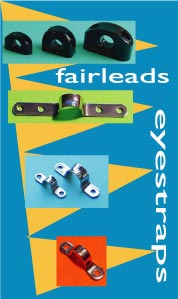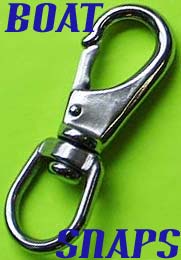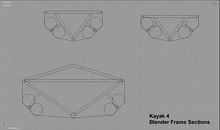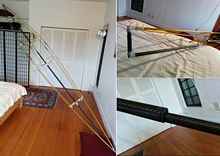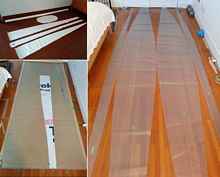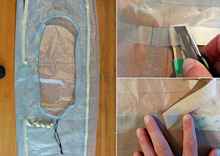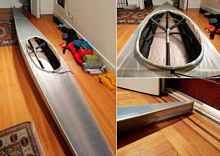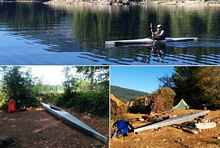
 Custom Search
|
| boat plans |
| canoe/kayak |
| electrical |
| epoxy/supplies |
| fasteners |
| gear |
| gift certificates |
| hardware |
| hatches/deckplates |
| media |
| paint/varnish |
| rope/line |
| rowing/sculling |
| sailmaking |
| sails |
| tools |
| join |
| home |
| indexes |
| classifieds |
| calendar |
| archives |
| about |
| links |
| Join Duckworks Get free newsletter CLICK HERE |
|
|
| Building a Cuben Fiber Folding Kayak - Part Two |
by Tim Evans, Vancouver, British Columbia |
Part 2 - 12.9 pound 17 footer
Overview Design I concentrated on the cross sections to determine how to build the boat and how to incorporate the sponsons. The drawing below shows what I came up with.
I wanted to build the entire frame using the tent pole tubing I had used before, including the cross frames. I wanted to do this partly as a challenge, but also because I couldn't see another way to support pairs of sponsons. Frames are normally cut as curved shapes from some kind of sheet material like high-density polyethyene. To make the cross frames from tubes, I would have to start with triangles, then add posts to the sides of the triangles that would support stringers for the sponsons. Whew! Sounds complicated, and I guess it is a bit. I was also a bit worried that my legs would rest uncomfortably against the sides of the triangle of the forward cockpit frame, but this turned out not to be much of a problem. To allow finer ends on the boat, I would use 2.5 inch diameter sponsons, a lot smaller than the 3.5 inch ones I had used before. And since the height of two sponsons no longer determined the height of the hull, the diameter wasn't critical anyway. To create a more sliver-like appearance a la K1, I decided to drop the heights of the ends. The center height would be 8 inches, the bow 6 inches and the stern 4 inches. Another change from the first boat was to incorporate a raised area in the deck forward of the cockpit to provide more leg room when entering and exiting the boat. For this design I used Blender extensively, creating a full 3D mesh for the hull. This allowed me to extract dimensions for the patterns directly from Blender.
Materials and Construction As before I wanted to use carbon tubing for the keel tube and tent poles for the rest of the frame. Again, I would use nylon tees for the tube connections, though this time they would be much more complicated. Since I was not aware of anyone making 2.5 inch diameter sponsons (at least not 15 foot long ones), I would have to get some custom ones made. Fortunately, I live in the same town as Feathercraft, and was able to get them to make me two double tubes in one piece each to my specs. The skin would be more complicated than the previous boat, but I was confident I could make it without much difficulty. What I wasn't sure about was the frame. This was a complete unknown, so I decided to start with it. Frame
Towards the end of the frame construction I hit on a way to avoid offsetting the tubes. The bow and stern cross frames were eventually make planer by cutting away half of each keel tee so as to overlap them as shown below for the stern frame.
This method involved some extreme bending of the upper tees, which was difficult, so I left the larger frames as they were and I ended up with two frame types. In the vein of pursuing a more nuanced design this time around, I wanted to take advantage of the fact that the bending force on the frame would be greatest in the center where I would be sitting on it, and least at the ends. This meant that continuing the large diameter of the keel tube all the way to each end would be wasteful. A tapered tube would be the most efficient, but impractical. A compromise would be to step the keel tube down to a smaller diameter at some point. I chose that point and had a 3D printed part made to step the tube down from 1.125 inch diameter to 0.75 inch. This also meant the stem fittings could now be made of the smaller diameter tubing, thus saving more weight. One small detail remained. How was I going to join the two gunwale tubes to the stem? This was a three-way joint at a shallow angle, which would not work with the 90 degree tees I had been using. The answer was found online (where else?) with nylon 'Y' connectors, in just the right diameter. Yes, the gods were smiling on me. And the frame was finished.
The Patterns
The Skin
The Finished Kayak
Not surprisingly, the full frame made a big difference to the longitudinal stiffness and resulted in a more pleasing shape than the first boat. The downside is much greater complexity than the 14 footer. Ah, life! It's so full of compromises. In Use
Contact: tim_evans@shaw.ca |
To comment on Duckworks articles, please visit one of the following:
|
 |
